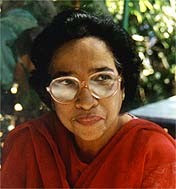The story of Amy Carmichael is fascinating for its sheer grit and immense faith that led her to a life of service to the poor, the downtrodden and the exploited. Unpredictable and independent by nature, she did not fit into any Missionary community who usually separated themselves in “other worldly” bubbles, keeping their distance away from the very people they wished to serve. Through her unflinching trust in God, she led a life of faith and victory.
Amy Carmichael was born on 16th December 1867,
in County Town, North Ireland, to David and Catherine Carmichael. They belonged
to the Presbyterian Church. Her mother was a woman of strong faith and Amy
inherited her ‘apostolic spirit’. Her father owned several flour mills and the
family was fairly well off. She attended the Wesleyan Methodist School. They
moved to Belfast because of changes in the milling business. However, not very
long after, her father’s business collapsed. The shock brought about his death
in 1885. Amy now had to drop out of school to help her mother take care of her
brothers and sisters. She was the eldest in a family of seven children.
One Sunday while returning from church, Amy saw a poor
old woman straining under the bundle she was carrying. With the help of her
brothers, the woman was relieved of her bundle and escorted to her house. She
was moved by the woman’s poverty. It brought about a change in her life’s
values and she decided that her calling would be to help the poor.
Amy would often accompany her pastor to distribute food
and tracts in the poor quarter of town. She had a burden for the poor girls who
worked in the mills and started a ministry among them, beginning with Sunday school.
She even moved into their neighborhood and slept in their bug infested beds.
They were called ‘shawlies’ because they couldn’t afford to buy hats and wore
shawls instead. Through her efforts she found a hall where they could meet. It
later became the Welcome Evangelical Church. Her time here prepared her for
full time ministry.
In 1886, Amy was invited to the Keswick Convention in
Glasgow. It was here that she became convinced of her calling for missionary
work. She was sent abroad by the Keswick Convention, and her first trip abroad
was to Japan in 1893. However, it lasted for only 15 months due to ill health.
She then moved briefly to China and then to Ceylon, but had to return to
England in 1894.
It took her just a year to set out again, and on November
9th, 1895, she sailed to India under the authority of the Church of
England’s Zenana Ministry Society. Amy’s idea of service and ministry did not
go down well with other missionaries. She wanted to pattern her work along the
lines of Hudson Taylor’s ministry in China. The blue print for her work dropped
unexpectedly into her lap.
On March 6th 1901, a girl of seven called
Preena, landed on her doorstep. She had absconded from a temple where she had
been initiated into the life of a temple prostitute. Her parents had sold her
into the service of a Goddess. This was just a smoke screen for prostitution.
The girl had sought protection in the Mission compound.
Amy was aware of the risk she was taking in sheltering
the girl. She could have been charged with kidnapping which invited
imprisonment for seven years. But in spite of brushes with the Law, this brave
lady made the rescue of ‘devadasis’
like this girl, her life’s mission.
And so began the Dohnavur Mission – an orphanage for
girls who were saved from defilement and prostitution. She became ‘Amma’
(mother) to these girls. She began to wear a sari and even dyed her skin with
coffee decoction, to blend with her protégés. Amy did not solicit funds for her
work, but whatever donations came in went into the Missionary account to be
dispensed ‘as the Lord directed.’ The Mission never borrowed money or went into
debt.
Amy chose her helpers carefully especially as she
espoused a “no salary policy.” They had to be committed to Christ and work for
the welfare of the inmates. Her little band was called “Sisters of Common
Life.” Young women who wished to serve at Dohnavur were cautioned “Missionary
work is simply a chance to die.”
In 1904 there were 17 children. But by 1918 the number
increased to 130. Then babies were also brought to her. In 1918, a section was
opened for boys who were also sold into temple slavery. Some of them were
children of prostitutes. Earlier, in 1912, a hospital sprung up on the campus,
which was funded by Queen Mary.
Amy was an avid reader. She read not just different
translations of the Bible, but history of the Church fathers, of mystics and
even Greek philosophers. It was her way of relaxing after a day of heavy work.
She was also a prolific writer. She wrote 52 books of various kinds – the story
of Dohnavur, stories of children who were rescued, poems, devotionals and
meditations. Her staunch but simple faith echoed through her writings.
Amy lost her usual activity after she suffered a fall on
October 24th, 1931. She was physically confined to her
room, but
continued to direct her ministry. During the next 20 years she wrote 13 books
and many letters. But when she fell for the second time in 1948, she was
confined to her bed until her death on January 18, 1951, at the age of 83. No
tombstone marks her grave. A bird bath with a simple inscription “Amma” stands
over the spot.
The work of Dohnavur Fellowship continues even today. It
is now functioning under the CSI Tinnevelly Diocese.



No comments:
Post a Comment